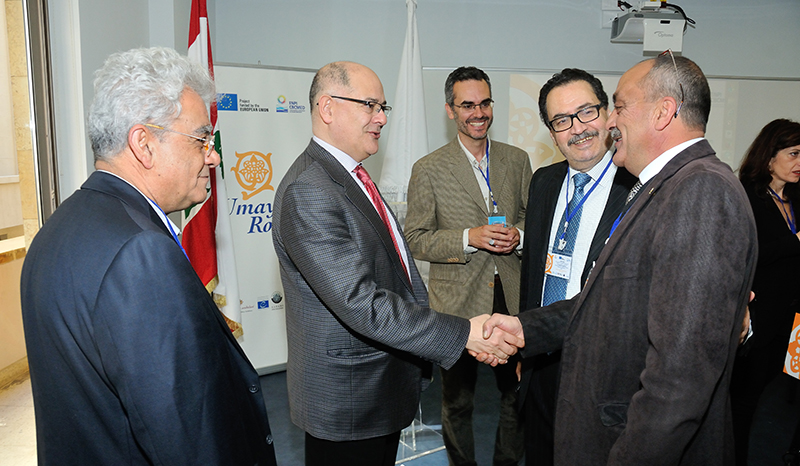Connecting Cultures with the Umayyad Route
In Lebanon’s fertile Bekaa Valley, lush vineyards and rolling farmland are paired with some of the world’s most important and spectacular historic sites. Baalbek, in particular, is famous for its beautiful Roman ruins, but these are not the only significant historic traces in the city. An Umayyad mosque is also located in Baalbek, retaining the original foundations and lower walls. Even more important is the Umayyad city at Anjar. The large palatial structure includes a main street, markets, residence and royal enclosure, providing an important overview of the city’s original layout and components.
Thanks to the Umayyad Route project, these historic sites are set to receive an influx of overseas visitors, along with other important archaeological sites in Lebanon, including Beirut, Byblos, Sidon, Tripoli and Tyre.
Launched in 2012, the Umayyad Route project is a collaboration between Egypt, Italy, Jordan, Lebanon, Portugal, Spain and Tunisia, led by public foundation The Legacy of al-Andalus. The aim is to foster a seasonal spread of tourism across the seven participating countries through a collaboration that highlights cultural tourism and the rich history of the partner countries, all of which boast Umayyad sites.
Principal partners in Lebanon include the Safadi Foundation, the Municipalities of Byblos and Anjar and the Urban Planning Institute at the Lebanese American University.
“The Umayyad route is a way to lead people,” explains Dr. Rachid Chamoun, director of the Urban Planning Institute. “Along the way they will be visiting the Umayyad culture but they will be learning about other cultures too. We have stories to tell… They will see things from before the Umayyads, like the Romans, and after the Umayyads they could be seeing Mamluk, Ottoman, or Crusader sites.”
The project’s four-year preparation stage, which comes to an end in December, included intensive capacity building workshops for tour operators in Lebanon, preparing them to present and contextualize Lebanon’s historic sites for an international public. “The tour operators will deal with tourists coming through this itinerary to discover the culture and the country,” says Chamoun. “They will be oriented to routes of commerce, to the silk roads, to how these cities are tied together.”
The project has a budget of over four million euros, 90 percent of which is supplied by the European Union’s ENPI CBC Med Programme and the final ten percent by the partner organizations.
LAU played a crucial role in the project. “LAU participated in local and international steering committee meetings in Spain, Tunisia, Alexandria, Rome, Palermo, Portugal and Lebanon,” says Chamoun. “LAU is really playing a guidance role to all of the Lebanese partners, not only when it comes to writing and reviewing the literature, but even when it comes to logistics and preparation. We get our students involved in mapping these cities. We have a wonderful portfolio of posters about the various cities, and now we are working on a publication, a guidebook for this project.”
Most exciting for Lebanon is a museum planned for the city of Anjar, which will highlight the historic links between the partner countries. “The launching of the museum could be in one year. We’ve already finished building the concrete,” says Chamoun. “Now it’s an issue of finishing the interior of the building and the facades and the landscaping. The municipality is also donating a piece of land in front of the museum called the Umayyad Square, with fountains and outdoor furniture. There will be outdoor projections and canopies, and within ten minutes you can walk to the heritage site of Umayyad Anjar.”
The museum will not contain physical artefacts, instead providing a virtual overview of the route.
“It’s a purely digital museum, with a library and user-friendly touch screens where you can visit cities and zoom in,” explains Chamoun. “You won’t only see the Lebanese Umayyad itinerary, you’ll get the chance to see the other partners’ itineraries. If you’re interesting in learning about the specific monuments you can go to each one, so we have a great deal of literature involved.”
The literature for the museum was developed by LAU’s Dr. Abdallah Kahil, director of the Institute of Islamic Art and Architecture, which collaborated with the Urban Planning Institute on this project. “I was asked to write an introduction for the whole Mediterranean project, in addition to writing the material for the Lebanese project,” explains Kahil. “I’m an art and architectural historian. I deal mostly with Islamic monuments, and the Umayyad sites are part of that. We will give the information to the museum… We have what was developed in the last few years, and some student work in mapping and working on the specificities of various sites in Lebanon.”
